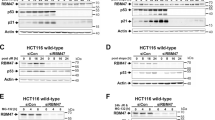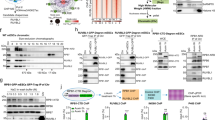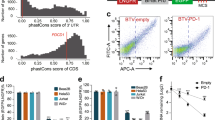Abstract
Both RBP1 and the highly related protein BCAA play a role in the induction of growth arrest and cellular senescence via mechanisms involving transcriptional repression. While investigating the transcriptional repression activities of RBP1, we observed a genetic link between RBP1 and SIR2. Further work uncovered an interaction between RBP1 family proteins and the mammalian homologue of SIR2, SIRT1. Interestingly, the HDAC-dependent transcriptional repression domain of RBP1 proteins, termed R2, is necessary and sufficient for the interaction with SIRT1. In vitro and in vivo binding studies indicated that the p33ING1b and p33ING2 subunits of the mSIN3A/HDAC1 complex are responsible for the recruitment of SIRT1 to the R2 domain. To investigate the biological relevance of this interaction, we used the sirtuin activator resveratrol and the sirtuin inhibitor sirtinol in transcriptional repression assays and demonstrated that SIRT1 activity negatively regulates R2-mediated transcriptional repression activity. We therefore propose a novel mechanism of class I HDAC regulation by a class III HDAC. Explicitly, SIRT1 is recruited by ING proteins and inhibits R2-associated mSIN3A/HDAC1 transcriptional repression activity.
This is a preview of subscription content, access via your institution
Access options
Subscribe to this journal
Receive 50 print issues and online access
$259.00 per year
only $5.18 per issue
Buy this article
- Purchase on Springer Link
- Instant access to full article PDF
Prices may be subject to local taxes which are calculated during checkout





Similar content being viewed by others
References
Bae NS, Swanson MJ, Vassilev A, Howard BH . (2004). Human histone deacetylase SIRT2 interacts with the homeobox transcription factor HOXA10. J Biochem (Tokyo) 135: 695–700.
Baylin SB, Esteller M, Rountree MR, Bachman KE, Schuebel K, Herman JG . (2001). Aberrant patterns of DNA methylation, chromatin formation and gene expression in cancer. Hum Mol Genet 10: 687–692.
Binda O, Roy J-S, Branton PE . (2006). RBP1 family proteins exhibit SUMOylation-dependent transcriptional repression and induce cell growth inhibition reminiscent of senescence. Mol Cell Biol 26: 1917–1931.
Blander G, Guarente L . (2004). The SIR2 family of protein deacetylases. Annu Rev Biochem 73: 417–435.
Bordone L, Motta MC, Picard F, Robinson A, Jhala US, Apfeld J et al. (2006). Sirt1 regulates insulin secretion by repressing UCP2 in pancreatic β cells. PLoS Biol 4: e31.
Bouras T, Fu M, Sauve AA, Wang F, Quong AA, Perkins ND et al. (2005). SIRT1 deacetylation and repression of p300 involves lysine residues 1020/1024 within the cell cycle regulatory domain 1. J Biol Chem 280: 10264–10276.
Braunstein M, Rose AB, Holmes SG, Allis CD, Broach JR . (1993). Transcriptional silencing in yeast is associated with reduced nucleosome acetylation. Genes Dev 7: 592–604.
Dannenberg J-H, David G, Zhong S, van der Torre J, Wong WH, DePinho RA . (2005). mSin3A corepressor regulates diverse transcriptional networks governing normal and neoplastic growth and survival. Genes Dev 19: 1581–1595.
Doyon Y, Cayrou C, Ullah M, Landry A-J, Côté V, Selleck W et al. (2006). ING tumor suppressor proteins are critical regulators of chromatin acetylation required for genome expression and perpetuation. Mol Cell 21: 51–64.
Finnin MS, Donigian JR, Cohen A, Richon VM, Rifkind RA, Marks PA et al. (1999). Structures of a histone deacetylase homologue bound to the TSA and SAHA inhibitors. Nature 401: 188–193.
Fischle W, Dequiedt F, Hendzel MJ, Guenther MG, Lazar MA, Voelter W et al. (2002). Enzymatic activity associated with class II HDACs is dependent on a multiprotein complex containing HDAC3 and SMRT/N-CoR. Mol Cell 9: 45–57.
Fleischer TC, Yun UJ, Ayer DE . (2003). Identification and characterization of three new components of the mSin3A corepressor complex. Mol Cell Biol 23: 3456–3467.
Garkavtsev I, Kazarov A, Gudkov A, Riabowol K . (1996). Suppression of the novel growth inhibitor p33ING1 promotes neoplastic transformation. Nat Genet 14: 415–420.
Garkavtsev I, Riabowol K . (1997). Extension of the replicative life span of human diploid fibroblasts by inhibition of the p33ING1 candidate tumor suppressor. Mol Cell Biol 17: 2014–2019.
Grozinger CM, Chao ED, Blackwell HE, Moazed D, Schreiber SL . (2001). Identification of a class of small molecule inhibitors of the sirtuin family of NAD-dependent deacetylases by phenotypic screening. J Biol Chem 276: 38837–38843.
Guarente L . (2005). Calorie restriction and SIR2 genes—towards a mechanism. Mech Ageing Dev 126: 923–928.
Guarente L, Picard F . (2005). Calorie restriction—the SIR2 connection. Cell 120: 473–482.
Hassig CA, Fleischer TC, Billin AN, Schreiber SL, Ayer DE . (1997). Histone deacetylase activity is required for full transcriptional repression by mSin3A. Cell 89: 341–347.
Hay RT . (2005). SUMO: a history of modification. Mol Cell 18: 1–12.
Heinzel T, Lavinsky RM, Mullen T-M, Soderstrom M, Laherty CD, Torchia J et al. (1997). A complex containing N-CoR, mSln3 and histone deacetylase mediates transcriptional repression. Nature 387: 43–48.
Herrscher RF, Kaplan MH, Lelsz DL, Das C, Scheuermann R, Tucker PW . (1995). The immunoglobulin heavy-chain matrix-associating regions are bound by bright: a B cell-specific trans-activator that describes a new DNA- binding protein family. Genes Dev 9: 3067–3082.
Howitz KT, Bitterman KJ, Cohen HY, Lamming DW, Lavu S, Wood JG et al. (2003). Small molecule activators of sirtuins extend Saccharomyces cerevisiae lifespan. Nature 425: 191–196.
Huang EY, Zhang J, Miska EA, Guenther MG, Kouzarides T, Lazar MA . (2000). Nuclear receptor corepressors partner with class II histone deacetylases in a Sin3-independent repression pathway. Genes Dev 14: 45–54.
Imai S-i, Armstrong CM, Kaeberlein M, Guarente L . (2000). Transcriptional silencing and longevity protein Sir2 is an NAD-dependent histone deacetylase. Nature 403: 795–800.
Kaeberlein M, McVey M, Guarente L . (1999). The SIR2/3/4 complex and SIR2 alone promote longevity in Saccharomyces cerevisiae by two different mechanisms. Genes Dev 13: 2570–2580.
Kataoka H, Bonnefin P, Vieyra D, Feng X, Hara Y, Miura Y et al. (2003). ING1 represses transcription by direct DNA binding and through effects on p53. Cancer Res 63: 5785–5792.
Khochbin S, Verdel A, Lemercier C, Seigneurin-Berny D . (2001). Functional significance of histone deacetylase diversity. Curr Opin Genet Dev 11: 162–166.
Kim S, Benguria A, Lai C-Y, Jazwinski SM . (1999). Modulation of life-span by histone deacetylase genes in Saccharomyces cerevisiae. Mol Biol Cell 10: 3125–3136.
Kortschak RD, Tucker PW, Saint R . (2000). ARID proteins come in from the desert. Trends Biochem Sci 25: 294–299.
Kuzmichev A, Zhang Y, Erdjument-Bromage H, Tempst P, Reinberg D . (2002). Role of the Sin3-histone deacetylase complex in growth regulation by the candidate tumor suppressor p33ING1. Mol Cell Biol 22: 835–848.
Laherty CD, Billin AN, Lavinsky RM, Yochum GS, Bush AC, Sun J-M et al. (1998). SAP30, a component of the mSin3 corepressor complex involved in N-CoR-mediated repression by specific transcription factors. Mol Cell 2: 33–42.
Laherty CD, Yang W-M, Sun J-M, Davie JR, Seto E, Eisenman RN . (1997). Histone deacetylases associated with the mSin3 corepressor mediate mad transcriptional repression. Cell 89: 349–356.
Lai A, Kennedy BK, Barbie DA, Bertos NR, Yang XJ, Theberge M-C et al. (2001). RBP1 recruits the mSIN3-histone deacetylase complex to the pocket of retinoblastoma tumor suppressor family proteins found in limited discrete regions of the nucleus at growth arrest. Mol Cell Biol 21: 2918–2932.
Lai A, Lee JM, Yang W-M, DeCaprio JA, Kaelin Jr WG, Seto E et al. (1999a). RBP1 recruits both histone deacetylase-dependent and -independent repression activities to retinoblastoma family proteins. Mol Cell Biol 19: 6632–6641.
Lai A, Marcellus RC, Corbeil HB, Branton PE . (1999b). RBP1 induces growth arrest by repression of E2F-dependent transcription. Oncogene 18: 2091–2100.
Langley E, Pearson M, Faretta M, Bauer U-M, Frye RA, Minucci S et al. (2002). Human SIR2 deacetylates p53 and antagonizes PML/p53-induced cellular senescence. EMBO J 21: 2383–2396.
Li J, Wang J, Wang J, Nawaz Z, Liu JM, Qin J et al. (2000). Both corepressor proteins SMRT and N-CoR exist in large protein complexes containing HDAC3. EMBO J 19: 4342–4350.
Longo VD, Kennedy BK . (2006). Sirtuins in aging and age-related disease. Cell 126: 257–268.
Lu R, Serrero G . (1999). Resveratrol, a natural product derived from grape, exhibits antiestrogenic activity and inhibits the growth of human breast cancer cells. J Cell Physiol 179: 297–304.
Luo J, Nikolaev AY, Imai S-i, Chen D, Su F, Shiloh A et al. (2001). Negative control of p53 by Sir2α promotes cell survival under stress. Cell 107: 137–148.
Meehan WJ, Samant RS, Hopper JE, Carrozza MJ, Shevde LA, Workman JL et al. (2004). Breast cancer metastasis suppressor 1 (BRMS1) forms complexes with retinoblastoma-binding protein 1 (RBP1) and the mSin3 histone deacetylase complex and represses transcription. J Biol Chem 279: 1562–1569.
Michan S, Sinclair D . (2007). Sirtuins in mammals: insights into their biological function. Biochem J 404: 1–13.
Michishita E, Park JY, Burneskis JM, Barrett JC, Horikawa I . (2005). Evolutionarily conserved and nonconserved cellular localizations and functions of human SIRT proteins. Mol Biol Cell 16: 4623–4635.
Minucci S, Pelicci PG . (2006). Histone deacetylase inhibitors and the promise of epigenetic (and more) treatments for cancer. Nat Rev Cancer 6: 38–51.
Nagy L, Kao H-Y, Chakravarti D, Lin RJ, Hassig CA, Ayer DE et al. (1997). Nuclear receptor repression mediated by a complex containing SMRT, mSin3A, and histone deacetylase. Cell 89: 373–380.
Nikolaev AY, Papanikolaou NA, Li M, Qin J, Gu W . (2004). Identification of a novel BRMS1-homologue protein p40 as a component of the mSin3A/p33ING1b/HDAC1 deacetylase complex. Biochem Biophys Res Commun 323: 1216–1222.
North BJ, Marshall BL, Borra MT, Denu JM, Verdin E . (2003). The human Sir2 ortholog, SIRT2, is an NAD+-dependent tubulin deacetylase. Mol Cell 11: 437–444.
North BJ, Schwer B, Ahuja N, Marshall B, Verdin E . (2005). Preparation of enzymatically active recombinant class III protein deacetylases. Methods 36: 338–345.
Ota H, Akishita M, Eto M, Iijima K, Kaneki M, Ouchi Y . (2007). Sirt1 modulates premature senescence-like phenotype in human endothelial cells. J Mol Cell Cardiol 43: 571–579.
Ota H, Tokunaga E, Chang K, Hikasa M, Iijima K, Eto M et al. (2006). Sirt1 inhibitor, sirtinol, induces senescence-like growth arrest with attenuated Ras-MAPK signaling in human cancer cells. Oncogene 25: 176–185.
Parsons XH, Garcia SN, Pillus L, Kadonaga JT . (2003). Histone deacetylation by Sir2 generates a transcriptionally repressed nucleoprotein complex. PNAS 100: 1609–1614.
Patsialou A, Wilsker D, Moran E . (2005). DNA-binding properties of ARID family proteins. Nucleic Acids Res 33: 66–80.
Pedeux R, Sengupta S, Shen JC, Demidov ON, Saito S, Onogi H et al. (2005). ING2 regulates the onset of replicative senescence by induction of p300-dependent p53 acetylation. Mol Cell Biol 25: 6639–6648.
Picard F, Kurtev M, Chung N, Topark-Ngarm A, Senawong T, Machado de Oliveira R et al. (2004). Sirt1 promotes fat mobilization in white adipocytes by repressing PPAR-γ. Nature 429: 771–776.
Qiu Y, Zhao Y, Becker M, John S, Parekh BS, Huang S et al. (2006). HDAC1 acetylation is linked to progressive modulation of steroid receptor-induced gene transcription. Mol Cell 22: 669–679.
Rogina B, Helfand SL . (2004). Sir2 mediates longevity in the fly through a pathway related to calorie restriction. PNAS 101: 15998–16003.
Rogina B, Helfand SL, Frankel S . (2002). Longevity regulation by Drosophila Rpd3 deacetylase and caloric restriction. Science 298: 1745.
Rountree MR, Bachman KE, Herman JG, Baylin SB . (2001). DNA methylation, chromatin inheritance, and cancer. Oncogene 20: 3156–3165.
Sasaki T, Maier B, Bartke A, Scrable H . (2006). Progressive loss of SIRT1 with cell cycle withdrawal. Aging Cell 5: 413–422.
Sgambato A, Ardito R, Faraglia B, Boninsegna A, Wolf FI, Cittadini A . (2001). Resveratrol, a natural phenolic compound, inhibits cell proliferation and prevents oxidative DNA damage. Mutat Res 496: 171–180.
Shore D, Squire M, Nasmyth KA . (1984). Characterization of two genes required for the position-effect control of yeast mating-type genes. EMBO J 3: 2817–2823.
Skowyra D, Zeremski M, Neznanov N, Li M, Choi Y, Uesugi M et al. (2001). Differential association of products of alternative transcripts of the candidate tumor suppressor ING1 with the mSin3/HDAC1 transcriptional corepressor complex. J Biol Chem 276: 8734–8739.
Takata T, Ishikawa F . (2003). Human Sir2-related protein SIRT1 associates with the bHLH repressors HES1 and HEY2 and is involved in HES1- and HEY2-mediated transcriptional repression. Biochem Biophys Res Commun 301: 250–257.
Thiagalingam SAM, Cheng K-H, Lee HJ, Mineva N, Thiagalingam A, Ponte JF . (2003). Histone deacetylases: unique players in shaping the epigenetic histone code. Ann NY Acad Sci 983: 84–100.
Tissenbaum HA, Guarente L . (2001). Increased dosage of a sir-2 gene extends lifespan in Caenorhabditis elegans. Nature 410: 227–230.
Underhill C, Qutob MS, Yee S-P, Torchia J . (2000). A novel nuclear receptor corepressor complex, N-CoR, contains components of the mammalian SWI/SNF complex and the corepressor KAP-1. J Biol Chem 275: 40463–40470.
Vaquero A, Scher M, Lee D, Erdjument-Bromage H, Tempst P, Reinberg D . (2004). Human SirT1 interacts with histone H1 and promotes formation of facultative heterochromatin. Mol Cell 16: 93–105.
Vaziri H, Dessain SK, Eaton EN, Imai S-i, Frye RA, Pandita TK et al. (2001). hSIR2SIRT1 functions as an NAD-dependent p53 deacetylase. Cell 107: 149–159.
Vieyra D, Loewith R, Scott M, Bonnefin P, Boisvert F-M, Cheema P et al. (2002). Human ING1 proteins differentially regulate histone acetylation. J Biol Chem 277: 29832–29839.
Wilsker D, Probst L, Wain HM, Maltais L, Tucker PW, Moran E . (2005). Nomenclature of the ARID family of DNA-binding proteins. Genomics 86: 242–251.
Wilson J, Le V, Zimmerman C, Marmorstein R, Pillus L . (2006). Nuclear export modulates the cytoplasmic Sir2 homologue Hst2. EMBO Rep 7: 1247–1251.
Yoon H-G, Chan DW, Huang Z-Q, Li J, Fondell JD, Qin J et al. (2003). Purification and functional characterization of the human N-CoR complex: the roles of HDAC3, TBL1 and TBLR1. EMBO J 22: 1336–1346.
Zhang Y, Sun Z-W, Iratni R, Erdjument-Bromage H, Tempst P, Hampsey M et al. (1998). SAP30, a novel protein conserved between human and yeast, is a component of a histone deacetylase complex. Mol Cell 1: 1021–1031.
Acknowledgements
We thank Laurent Huck and Peter Moffett for critically reviewing this manuscript, and Jean-Sébastien Roy for valuable discussions. This work was supported through grants from the Canadian Cancer Society, the National Cancer Institute of Canada and the Canadian Institutes for Health Research.
Author information
Authors and Affiliations
Corresponding author
Additional information
Supplementary Information accompanies the paper on the Oncogene website (http://www.nature.com/onc).
Rights and permissions
About this article
Cite this article
Binda, O., Nassif, C. & Branton, P. SIRT1 negatively regulates HDAC1-dependent transcriptional repression by the RBP1 family of proteins. Oncogene 27, 3384–3392 (2008). https://doi.org/10.1038/sj.onc.1211014
Received:
Revised:
Accepted:
Published:
Issue Date:
DOI: https://doi.org/10.1038/sj.onc.1211014
Keywords
This article is cited by
-
SIRT1 coordinates with the CRL4B complex to regulate pancreatic cancer stem cells to promote tumorigenesis
Cell Death & Differentiation (2021)
-
Resonance assignments for the tandem PWWP-ARID domains of human RBBP1
Biomolecular NMR Assignments (2019)
-
ING1b negatively regulates HIF1α protein levels in adipose-derived stromal cells by a SUMOylation-dependent mechanism
Cell Death & Disease (2015)
-
Sirtuins in stress response: guardians of the genome
Oncogene (2014)
-
ING1 and ING2: multifaceted tumor suppressor genes
Cellular and Molecular Life Sciences (2013)



